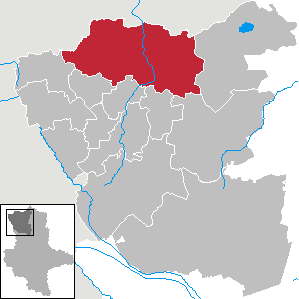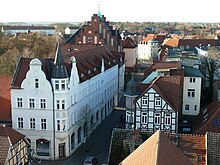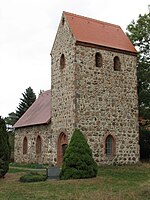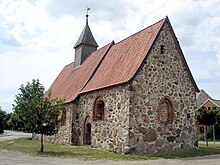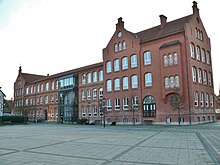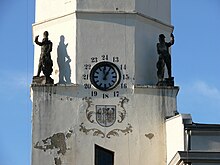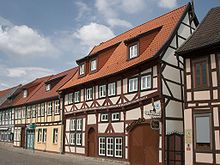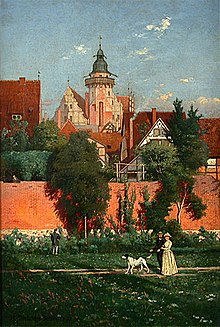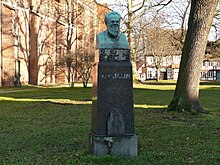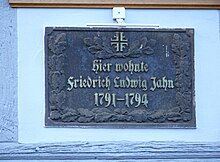Salzwedel
| coat of arms | Germany map | |
|---|---|---|

|
Coordinates: 52 ° 51 ' N , 11 ° 9' E |
|
| Basic data | ||
| State : | Saxony-Anhalt | |
| County : | Altmarkkreis Salzwedel | |
| Height : | 19 m above sea level NHN | |
| Area : | 304.58 km 2 | |
| Residents: | 23,453 (Dec. 31, 2019) | |
| Population density : | 77 inhabitants per km 2 | |
| Postal code : | 29410 | |
| Primaries : | 03901, 039032, 039033, 039037, 039038 | |
| License plate : | SAW, GA, KLZ | |
| Community key : | 15 0 81 455 | |
| LOCODE : | DE SZW | |
| NUTS : | DEE04 | |
City administration address : |
At the Mönchskirche 5 29410 Salzwedel |
|
| Website : | ||
| Mayoress : | Sabine Blümel | |
| Location of the district town of Salzwedel in the Altmarkkreis Salzwedel | ||
The Hanseatic city of Salzwedel [ ˈzaltsveːdəl ] is the district town of the Altmarkkreis Salzwedel in Saxony-Anhalt .
geography
Salzwedel is located in the northwestern part of the Altmark at the confluence of the Salzwedeler Dumme in the Jeetze . Neighboring regionally important cities are Uelzen (in the west, 44 km), Lüchow (in the north, 12 km), Gardelegen (in the south, 41 km) and Arendsee (in the east, 24 km).
City structure
The Hanseatic city of Salzwedel is divided into 17 localities (former municipalities) and 48 districts . The localities include the same name and other districts and residential areas:
|
|
|
Districts without localization are:
- Boeddenstedt
- Hoyersburg
- Kricheldorf and Sienau
- Kemnitz and Ziethnitz with the Phillips Colony residence
- Klein Wieblitz , Groß Wieblitz and Eversdorf
The core town of Salzwedel does not form a district. In addition, the settlements and residential areas Böddenstedter Mühle , Perver , Siebeneichen , Siedlung des Friedens and Siedlung Ost are located in the Salzwedel district .
On July 1, 2019, a change in the main statute came into effect: The village of Henningen only consists of the Henningen district. Two new localities were created: The locality Andorf, consisting of the Andorf district and the Grabenstedt district, and the Barnebeck district, consisting of the Barnebeck district.
Two earlier municipalities did not form localities after the incorporation:
- Steinitz with its districts of Kemnitz and Ziethnitz
- Wieblitz-Eversdorf with Eversdorf, Groß Wieblitz and Klein Wieblitz
history
Early history and the first settlement in the urban area
The earliest archaeological finds that indicate settlement are far outside of today's inner city area. In the neighboring Wendland , especially in the area around Lüchow , many Middle and Neolithic sites are known, some of which have been and are still being excavated. It can therefore be assumed that groups of hunters and gatherers have repeatedly visited the area around Salzwedel for at least 7,000 years.
After the last ice age, which ended around 14,000 years ago, there was a lake between Salzwedel and Wustrow in Wendland. People who temporarily settled on its banks left behind many flint tools, but also antler and bone tools. Some of these antler devices were found in the Jeetze.
Also from the middle and late Neolithic period (around 3600–2000 BC) only a few pieces come from the urban area. A late Bronze Age find of the old waterworks and a burial ground (around today's B71 ) indicate a permanent settlement of the nearby city area of Salzwedels since around 1000 BC. Chr. In the early Iron Age there was a cemetery around this area (from 700 BC) and a new cemetery called "Auf dem Höhe Felde" was built, which is very close by. At the end of the pre-Roman Iron Age from approx. 200 BC. New cemeteries were created on the Perver Windmühlenberg (south-east of Salzwedel) and on the former parade ground near Kricheldorf (south of Salzwedel). From the late Roman Empire and the Great Migration (180–500 AD) there are only very few individual finds.
Middle Ages and the Salzwedel Castle as the beginning of urban development
Since the year 800 a settlement has been assumed on the site of today's town in the vicinity of Salzwedel Castle . The old name Soltwidele refers to a ford through the Jeetze on the old salt road . The castle near Salzwedel was first mentioned in a document in 1112. Salzwedel leads the founding of the city to the margrave brothers Johann I and Otto III. back who lived temporarily at Salzwedel Castle; the first name as a city dates from the year 1233. From 1247, the new city emerged immediately northeast of the old town as a planned foundation and independent city. Both cities were within the city wall. It was not until 1713 that the old town and new town were combined. From 1263 to 1518 Salzwedel was a member of the Hanseatic League , so that extensive trade was carried out. Grain, hides, cloths and beer reached Gotland and Russia from the Hanseatic city . Mainly spices, herrings and also tin and copper vessels were shipped into the city via the Jeetze. Due to the high quality fabrics, Salzwedel was known far beyond the borders of the region as a “cloth maker workshop”. Street names such as Schmiede-, Wollweber- or Radestrasse and the paved coats of arms of the respective crafts testify to the former tradition in Salzwedel to this day.
In the Polabian ("Wendish") language of the area, which died out in the 18th century , Salzwedel was called Ljosdit (Lôsdît, Lósdy) , possibly derived from ljos ( Slavic lěsă , "forest").
Reformation and early modern times
The Reformation took hold in Salzwedel in 1541. The Thirty Years War brought the city to the brink of ruin without being besieged. The reason for this was the billeting of foreign troops. Including the mercenary Peter Hagendorf in winter camp from December 1627 to February 1628.
From the 16th century, Salzwedel belonged to the Salzwedelic Circle .
From 1800 until today
In 1816, Salzwedel became the seat of the Salzwedel district in the Prussian province of Saxony . In 1870 the city received a railway connection. As a result, the jets' shipping lost its importance. As a result, further rail lines were added.
After the First World War , Hoyersburg emerged as a district of Salzwedel. The settlement was founded primarily to settle Germans from Russia who mainly worked as forest workers for the city.
During the Second World War , a camp for forced laborers was set up on the site of a fertilizer factory in Gardelegener Strasse from 1942 , which was operated from the end of July 1944 to April 14, 1945 as the Salzwedel satellite camp , a women's camp of the Neuengamme concentration camp . Initially 400 and later up to 1,500 mostly Jewish prisoners of different nationalities had to do heavy labor in two twelve-hour shifts in ammunition production for the Salzwedel wire and metal factory , a subsidiary of Magdeburg's Polte-Werke . At the end of the Second World War, more and more women from other concentration camps were transported to the Salzwedel camp in front of the advancing Allies, and on April 14, 1945 the 9th US Army liberated 3,000 prisoners there.
The air raid carried out as part of Operation Clarion on February 22, 1945 destroyed the station area and killed around 300 people. However, the old town was largely preserved, as the targets of the attack were the railway lines and industrial buildings. However, during the GDR era, numerous old houses fell into disrepair.
From 1946 to 1950 Salzwedel was an independent city . In 1952 it was assigned to the newly founded Magdeburg district .
In the GDR, the city was the location of the helicopter squadron 16 of the air forces of the border troops of the GDR from April 1971 to April 1986 , then a branch of the Nordhausen site, most recently with Mil Mi-2 and Mil Mi-8 helicopters . Due to the location close to the border, many houses have been abandoned since the fall of the Wall in 1989, so that in 2007 an action was started to offer houses and land cheaply.
Since April 1, 2008 the city has had the addition of the Hanseatic City to its name .
Population development
|
|
(from 1998 to December 31st)
Incorporations
Incorporation to Salzwedel took place in 1908 (Perver), 1950 (Böddenstedt), 1974 (Krinau), 2003 (three municipalities), 2005 (Stappenbeck), 2009 (Benkendorf), 2010 (ten municipalities) and 2011 (two municipalities) .
| Former parish | date | annotation |
|---|---|---|
| Andorf | 05/01/1992 | Incorporation to Henningen |
| Barnebeck | 05/01/1992 | Incorporation to Henningen |
| Benkendorf | 01/01/2009 | |
| Boeddenstedt | 07/01/1950 | |
| Bombeck | 07/01/1950 | Incorporation to Osterwohle |
| Brewitz | 07/01/1950 | Incorporation to Dambeck |
| Brietz | 01/01/2003 | |
| Buchwitz | 07/01/1950 | Incorporation to Stappenbeck |
| Cheine | 03/01/1973 | Incorporation to Seebenau |
| Chudes | 01/01/2010 | |
| Chüttlitz | 03/01/1973 | Incorporation to Brietz |
| Dambeck | 01/01/2003 | |
| Depekolk | 07/01/1950 | Incorporation after Liesten |
| Eversdorf | 08/01/1972 | Merger with Wieblitz to Wieblitz-Eversdorf |
| Gerstedt | 10/01/1972 | Incorporation to Osterwohle |
| Grabenstedt | 01/01/1973 | Incorporation to Andorf |
| Great Chüden | December 01, 1972 | Merger with Ritze to Chüden |
| Great Grabenstedt | 07/01/1950 | Merger with Klein Grabenstedt zu Grabenstedt |
| Big Wieblitz | 07/01/1950 | Merger with Klein Wieblitz to form Wieblitz |
| Henningen | 01.01.1974 01.05.1990 01.01.2010 |
Incorporation to Langenapel. Separation from Langenapel. Incorporation to Salzwedel |
| Hestedt | 07/01/1950 | Incorporation to Andorf |
| Year sow | 07/01/1950 | Incorporation according to Jeebel |
| Jeebel | 01/01/1963 | Incorporation to Riebau |
| Kemnitz | 07/01/1950 | Merger with Ziethnitz zu Steinitz |
| Little boys | 07/01/1950 | Incorporation after Ritze |
| Klein Grabenstedt | 07/01/1950 | Merger with Groß Grabenstedt zu Grabenstedt |
| Klein Gartz | 01/01/2010 | |
| Klein Wieblitz | 07/01/1950 | Merger with Groß Wieblitz to form Wieblitz |
| Koenigstedt | 01/01/1992 | Incorporation after Pretzier |
| Kricheldorf | 07/01/1950 | Merger with Sienau zu Krinau |
| Krinau | 03/15/1974 | |
| Langenapel | 01/01/2010 | |
| Liesten | 01/01/2010 | |
| Mahlsdorf | 01/01/2003 | |
| Maxdorf | 07/01/1950 | Incorporation to Mahlsdorf |
| Osterwolle | 01/01/2010 | |
| Perver | 07/01/1908 | |
| Pretzier | 01/01/2010 | |
| Riebau | 01/01/2010 | |
| Crack | December 01, 1972 | Merger with Groß Chüden zu Chüden |
| Rockenthin | 07/01/1950 | Incorporation to Andorf |
| Seebenau | 01/01/2010 | |
| Sienau | 07/01/1950 | Merger with Kricheldorf zu Krinau |
| Stappenbeck | 01.01.1974 01.05.1990 01.01.2005 |
Incorporation to Mahlsdorf. Outsourcing from Mahlsdorf. Incorporation to Salzwedel |
| Steinitz | 01/01/2011 | |
| Tylsen | 01/01/2010 | |
| Wieblitz | 08/01/1972 | Merger with Eversdorf to Wieblitz-Eversdorf |
| Wieblitz-Eversdorf | 01/01/2011 | |
| Wistedt | 10/01/1972 | Incorporation to Osterwohle |
| Ziethnitz | 07/01/1950 | Merger with Kemnitz zu Steinitz |
politics
In the 15 localities except Benkendorf and Wieblitz-Eversdorf, the local constitution has been introduced and there is a local council (except in Steinitz).
City council
The local elections on May 26, 2019 led to the following result for the composition of the city council:
| Party / list | Share of votes | +/-% p | Seats | +/- |
|---|---|---|---|---|
| left | 17.9% | - 5.2 | 6th | - 2nd |
| CDU | 16.7% | - 10.4 | 6th | - 4th |
| AfD | 13.0% | + 13.0 | 5 | + 5 |
| SPD | 12.2% | - 0.8 | 4th | - 1 |
| Green | 7.7% | + 3.3 | 3 | + 1 |
| FDP | 3.9% | + 1.6 | 1 | ± 0 |
| Hanseatic Citizens Association Salzwedel | 15.5% | + 13.0 | 6th | + 5 |
| WG Salzwedel-Land | 11.8% | - 1.6 | 4th | - 1 |
| VILLAGE TO CITY | 1.4% | + 1.4 | 1 | + 1 |
In addition, the mayor is a member of the city council.
City administration
On March 9, 2008, Sabine Danicke was elected mayor of the Hanseatic city of Salzwedel. Due to the incorporation of Steinitz and Wieblitz-Eversdorf on January 1, 2011, the population of Salzwedel rose to over 25,000, so that Danicke was henceforth mayor.
In the mayoral election in 2015, Sabine Blümel won by just three votes. Due to the tight election result, however, Danicke appealed. On July 10, 2015, Danicke gave up her position to the Deputy Mayor Andreas Vogel, pending a decision by the Magdeburg Administrative Court . The 9th Chamber of the Magdeburg Administrative Court, chaired by administrative judge Uwe Haack, decided on December 15, 2015 that the mayoral election was valid. However, two votes were declared invalid, so that Sabine Blümel had won the runoff election on March 8, 2015 with just one vote. After a year of administrative disputes, the new mayor of Salzwedel, Sabine Blümel, was sworn in by the city council on March 16, 2016 and took up office one day later.
coat of arms
Blazon : “Split in silver; in front a half red eagle with gold reinforcement and breast clasp, next to it a raised red key with a beard turned back; in the back a red eagle with gold reinforcement and breast braces, in the claws two lying red keys in pegs, over the wings two steel-colored bucket helmets with black gold-decorated flight, in the crook of the neck a hexagonal gold star. "
Before 1713, the old and new towns of Salzwedel were two separate towns with their own coats of arms. The history of the coat of arms can be traced in the development of the seal images of both cities. Originally the old town carried a whole eagle with a key lying in its claws. The old town coat of arms emblazoned above did not develop until later in the course of the Middle Ages. After the unification of the old town and new town, both coats of arms were placed side by side in a shield. The old town carried the half Brandenburg eagle with the key upright, the new town the whole Brandenburg eagle with two lying keys, two helmets and a star.
flag
The colors of the Hanseatic city of Salzwedel are white and red. The city flag shows in the longitudinal direction an upper white and a lower red half. In the middle is the city coat of arms.
Town twinning
Salzwedel maintains partnerships with the following cities:
- Wesel , North Rhine-Westphalia , since 1990
- San Vito dei Normanni , in Apulia (Italy), since 1990
- Felixstowe , in Suffolk, southern England, since 1994
Culture and sights
Attractions
- Old town with numerous half-timbered houses
- City gates (Neupervertor, Steintor, fragments of the water gate and the Lüchower gate) and medieval city fortifications
- Remains of Salzwedel Castle (castle tower in the castle garden)
- Town hall (former Franciscan monastery)
- Former town hall in the old town, today's district court of Salzwedel
- Town hall tower of the former town hall of the new town (accessible renaissance tower with a view of the town)
- Romanesque and Gothic brick churches
- St. Mary
- St. Catherine's
- Mönchskirche (concert and event hall since 1986)
- St. Lorenz
- St. Gertrauden Chapel (formerly part of a hospital on the outside of the city fortifications)
- Dambeck Monastery (District Dambeck)
- Churches turned my deterministic villages: St. George in 1908 eingemeindeten Perver , village church Osterwohle , village church Dambeck
- Heilig-Geist-Kirche, church of a former hospital in front of the Altpervertor, formerly Gothic rotunda (!) 20 m in diameter with a single-nave brick choir, rotunda demolished in 1792, choir preserved
- Märchenpark Salzwedel as well as the scent and touch garden of Jeetzelandschaftssanierung GmbH on the Warthe
- Johann-Friedrich-Danneil-Museum (former provost office)
- Kunsthaus Salzwedel, in the listed former lyceum
- Jenny-Marx-Haus : Birthplace of Jenny Marx
- Bismarck Tower , a 25 m high observation tower on the Black Mountain ( ⊙ ), inaugurated in 1900 , approx. 4 km south-southwest of Salzwedel
- Praying Mantis - stylized large-scale sculpture of a praying mantis made of iron. The art object inaugurated on July 12, 2000 (title actually: For Walter - instead of flowers ) by Hilmsen artist Hans Molzberger is set up next to the choir of the monk's church and was Salzwedel’s contribution to Expo 2000 in Hanover. The city has now acquired the sculpture.
- Former bath house on the eastern Jeetzeumfluter. The house can only be reached via a narrow entrance from Goethestrasse or the promenade from Neuperver Tor.
- Goethepark on Goethestrasse
- By Salzwedel lead scenic routes Romanesque Route and the German Framework Road .
- The old mint was the city's mint . The late Gothic brick building was built in the first half of the 14th century and is used in the 21st century as the office of the Magdeburg Chamber of Commerce and Industry .
Memorials
- Memorial stone at the former Salzwedel subcamp in Gardelegener Strasse for the women prisoners who were deported there for forced labor and who perished
- Graves including a Soviet honor grove in the Perver cemetery in Arendseer Strasse for over 500 men and women who perished in forced labor and who were abducted to Germany during the Second World War
- Memorial complex on the outskirts of the city by the Ritzer Bridge for 244 concentration camp prisoners who lost their lives on a death march from one of the subcamps in April 1945
- Graves in the Neustädter Friedhof for nine women prisoners known by name from the subcamp who were victims of forced labor
- Burial in the cemetery of the local part Dambeck for twelve murdered concentration camp inmates, the 1,945 victims in a transport train, called in April lost train , from the Bergen-Belsen were
- On June 26, 2010 the Cologne artist Gunter Demnig laid a total of 16 stumbling blocks for 13 deported Jewish residents of Salzwedel and three surviving children at five locations in Salzwedel (on Altperverstrasse, Burgstrasse and Neuperverstrasse) .
Former buildings
- The Schwarzer Adler house next to the town hall tower is a former part of the Neustadt town hall, the Gothic upper floor of which was demolished in 1801. It has not been in the hands of the city since 1820.
- 1792 Demolition of the nave of the Heilig-Geist-Kirche
- In 1797 the Nikolaikirche in the old town was demolished.
Music and bands
- The post-punk band Rosengarten comes from Salzwedel.
- The Salzwedel association "Aktion Musik / local heroes eV" organizes and coordinates the Germany-wide band competition Local Heroes , which is aimed at young up-and-coming bands. The primary goal of the club located in the “Hanseatic” is to create good performance opportunities for young bands and to make them known in their home region and beyond.
Regular events
The largest and most traditional event is the annual Dionysius Market , or Nysmarkt for short . It takes place as a big city festival around the day of German unity . The Hansefest has established itself as another regular event at the beginning of June. These events are complemented by a pub night , a wine festival and a night of lights .
The national final of the Local Heroes band competition takes place every year as a major concert event. The contest has been held in Germany since 1990 and is organized and coordinated by the association “Aktion Musik / local heroes eV” (Salzwedel).
Until 2008 the Park Festival was known nationwide as a music festival held every two years with several thousand visitors and the participation of national and international bands and musicians. Due to the high cost, it is no longer performed. The Smack Festival, later Chemical Bash , one of the largest hard rock festivals in Saxony-Anhalt, also took place in Salzwedel.
Artist and scholarship house
Since 1997, the city has been sponsoring an artist and scholarship holder in the fields of visual arts, literature and music via a sponsoring association.
Sports
From 1955 to at least 1961, Salzwedel was the venue for the Jahn Memorial Sports Festival. The city hosted the 2006 World Cup for people with disabilities .
There are several sports clubs such as SV Eintracht Salzwedel 09 , ESV Lok Salzwedel, Hansebaskets Salzwedel, SV Brietz, BSV Salzwedel, Freizeit & Sport Siebeneichen eV, Reitverein St. Georg Salzwedel, the shooting club of the city of Salzwedel and the ship model club Salzwedel 1985.
In addition, some Salzwedel athletes were successful on a national and international level, such as Doris Maletzki , Irmgard Praetz , Petra Westing and Thomas Ulbricht .
Culinary specialties
Regional specialties are Salzwedeler tree cake , the Altmärkische wedding soup , pot roast (mutton) and the tongue ragout .
Religions
Almost 80 percent of Salzwedel’s residents are non-denominational .
The 2011 census in the European Union showed that of the 24,693 inhabitants of the city of Salzwedel, around 19% belonged to the Protestant and around 3% to the Catholic Church.
The Protestant Christians of the town of Salzwedel and the surrounding villages belong to three parish areas: St. Marien (in the old town), St. Katharinen (in the new town) and St. Georg (in Perver) in the parish of Salzwedel in the provost district of Stendal-Magdeburg of the Evangelical Church in central Germany .
The Catholic parish of St. Laurentius is administratively part of the Stendal deanery of the Magdeburg diocese . The church services of the congregation are held in the Lorenz Church.
In Salzwedel there are parishes of different free churches , z. B. the Adventist church , an Evangelical Free Church ( Baptist ) church and a Pentecostal church .
The New Apostolic Church is also represented on site.
In a Germany-wide comparison, the number of members of Islam and Judaism is low .
Economy and Infrastructure
economy
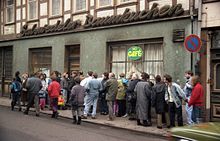
The Salzwedeler Baumkuchen, which is produced here in several companies, is known beyond the German borders. The "First Salzwedeler Baumkuchen-Fabrik" was founded in 1808 and in 1865 became supplier to the royal court . King Wilhelm I , the future German Emperor , visited the city at that time. In 1958, during the GDR era , the company was expropriated. The owner was sentenced to two years in prison at the age of 72. She was charged with depriving the GDR population of valuable raw materials by sending the tree cake to the Federal Republic . In 1990 the expropriated company was returned.
traffic
Street
The B 71 (Halle – Gardelegen – Salzwedel – Uelzen – Bremerhaven) crosses Salzwedel from northwest to southeast and the B 248 (Northeim – Wolfsburg – Salzwedel – Dannenberg) in a south-north direction, while the B 190 (Salzwedel– Arendsee - Seehausen ) starts from Salzwedel in an easterly direction. Salzwedel is the largest town in Germany furthest away from a motorway entrance (as of November 2012). To A 39 to Lüneburg there are 80.9 km, to A 2 at the triangle to 14 A 81.4 km and the A 39 in Wolfsburg km 59.5. A gap on the A 14 from Magdeburg via Stendal and Osterburg to Schwerin , which runs east of Salzwedel, is currently being implemented. Originally (1995) an X variant was planned, which was also approved by the ADAC and provided for a Salzwedel motorway junction made up of an extended A 39 and A 14.
railroad
The only train connection in operation is the Stendal – Uelzen railway line , which originally connected Bremen with Berlin and continued as the so-called American line to Bremerhaven to Columbuskaje . Salzwedel is located on the Stendal - Uelzen section that was reopened after the end of the German division in the direction of Uelzen . On this route there are connections with a regional express in the direction of Uelzen or Stendal - Magdeburg - Halle as well as by a regional train in the direction of Stendal, which serves all on-the-go stations. An Interregio-Express , which connects Berlin and Hamburg, has stopped in Salzwedel since April 2014 ; a weekend connection via IC on the same route was discontinued in December 2015. The Eurocity pair of trains Hamburg– Breslau disappeared from the offer in December 2014.
The line to Oebisfelde was closed in 2002 and the line to Wittenberge (via Arendsee (Altmark) ) in 2004.
Bus transport
Local public transport is provided by the PlusBus and TaktBus of the Saxony-Anhalt state network . The following connections lead from Salzwedel:
- Line 100: Salzwedel ↔ Klötze ↔ Gardelegen ↔ Haldensleben ↔ Magdeburg
- Line 200: Salzwedel ↔ Arendsee ↔ Seehausen (↔ Wittenberge )
- Line 300: Salzwedel ↔ Klötze ↔ Beetzendorf ↔ Oebisfelde
The Personenverkehrsgesellschaft Altmarkkreis Salzwedel mbH (PVGS) operates other routes from Salzwedel as well as the public dial-a-bus service in Salzwedel.
Aid organizations
- Salzwedel fire department
- Salzwedel medical train
- THW OV Salzwedel
education
In Salzwedel there is the Friedrich-Ludwig-Jahn-Gymnasium.
Personalities
sons and daughters of the town
- Abdias Praetorius (1524–1573), theologian and reformer
- Stephan Praetorius (1536–1603), theologian
- Georg Stampelius (1561–1622), theologian
- Jacob Reinecke (1572–1613), Lutheran theologian, provost in Cölln and chief pastor in Hamburg
- Benedikt Winkler (1579–1648), lawyer
- Georg Winckler (1582–1654), businessman
- Joachim Carstens (1596–1673), lawyer, syndic
- Johannes Klein (1604–1631), theologian
- Werner Theodor Martini (1626–1685), legal scholar
- Zacharias Stampeel (1654–1731), Lutheran theologian, educator and librarian
- Ulrich Christoph von Stille (1654–1728), Lieutenant General and Commandant of the Magdeburg Fortress
- Johann Gottfried Hornejus (1689–1757), theologian
- Joachim Wasserschlebe (1709–1787), diplomat in the Danish service and art collector
- Joachim Johann Daniel Zimmermann (1710–1767), theologian and writer
- Philipp Wilhelm Gercken (1722–1791), historian
- Christian Friedrich Christoph Stelzer (1738–1822), war councilor and domain councilor, syndic and mayor of Halle
- Christian Steltzer (1758–1831), lawyer and rector of the Imperial University of Dorpat
- Friedrich Gottfried Leue (1801–1872), lawyer, legal reformer, politician and author
- Jenny Marx (1814–1881), socialist, wife of Karl Marx
- Albert von Bennigsen-Foerder (1838–1886), Prussian district administrator
- Hermann Grothe (1839–1885), engineer and politician
- Werner von der Schulenburg (1841–1913), district administrator and member of the Reichstag
- Bernhard von der Schulenburg (1844–1929), major general and legal knight of the Order of St. John
- Karl Viereck (1853–1916), lawyer and politician
- Konrad Zechlin (1854–1936), local researcher and pharmacist
- Friedrich Meinecke (1862–1954), historian
- Ernst Hentschel (1876–1945), marine biologist
- Richard Stappenbeck (1880–1963), geologist
- Heinrich Gahrns (1882–1955), politician (CDU)
- Erhard Weyhe (1882–1972), German-American art bookseller and publisher
- Erich Dahlgrün (1895–1978), Protestant pastor
- Hans Georg Dahlgrün (1901–1974), lawyer and politician
- Hans Mettel (1903–1966), sculptor
- Kurt Schütte (1909–1998), mathematician
- Heinz Billing (1914–2017), honorary citizen, physicist and pioneer in computer development and research into gravitational waves
- Joachim Dorenburg (1915–1978), lawyer and politician
- Irmgard Praetz (1920–2008), athlete
- Helga Weyhe (* 1922), honorary citizen and bookseller
- Günter Mardus (1924–2020), physicist and politician (CDU)
- Christa Partsch (1926–2002), bookbinder and poet
- Lorenz Weinrich (* 1929), historian
- Christoph Albrecht (1930–2016), organist, conductor and composer
- Hans Rémond (* 1932), painter
- Alexander Kaul (* 1934), biophysicist
- Siegfried Pank (* 1936), cellist and gambist
- Uwe Herms (* 1937), writer
- Harald Lorscheider (1939–2005), composer
- Lutz Dieter Behrendt (* 1941), historian
- Alexander von Plato (* 1942), philosopher and historian
- Klaus Wallenstein (* 1943), archaeologist, miner and party official
- Konrad Halver (1944–2012), actor, radio play maker and voice actor
- Joachim Holz (* 1944), politician (DBD, CDU)
- Karl Kremser (* 1945), American football player
- Willibald Toscher (* 1948), politician (CDU)
- Christoph Noetzel (* 1950), church musician and composer
- Klaus Decker (* 1952), soccer player
- Doris Maletzki (* 1952), track and field athlete
- Jürgen Scharf (* 1952), state politician (CDU)
- Liane Deicke (* 1954), politician (SPD)
- Peter Urie (1955–2005), pastor and bishop in the Republic of Kazakhstan
- Mathias Löttge (* 1958), politician (CDU)
- Michael Ziche (* 1961), politician (CDU), district administrator of the Altmarkkreis Salzwedel
- Reneé Schmidt (* 1967), cycling coach
- Andy Böhme (* 1970), skeleton pilot
- Toralf Staud (* 1972), journalist and book author
- Ingmar Stadelmann (* 1980), stand-up comedian, speaker and radio host
- Michel Niemeyer (* 1995), football player
Persons connected with Salzwedel
- Nikolaus Krage († 1559), theologian and reformer, spent the last years of his life in Salzwedel
- Friedrich Ludwig Jahn (1778–1852), gymnastics father, attended high school in Salzwedel
- Johann Friedrich Danneil (1783–1868), prehistorian and local researcher, city chronicler, director of the Salzwedeler Gymnasium
- Wilhelm Harnisch (1787–1864), educator and writer, attended the Salzwedeler Gymnasium and described Salzwedel in Mein Lebensmorgen
- Hermann Wagener (1815–1889), conservative publicist and politician, attended high school in Salzwedel
- Hermann Hager (1816–1897), pharmacist and pharmacist, apprenticeship as a pharmacist in Löwenapotheke
- Hermann Masius (1818–1893), pedagogue, temporarily high school teacher in Salzwedel
- Bertha Behrens (1848–1912), writer (pseudonym: Wilhelmine Heimburg), began writing in Salzwedel
- Hugo Prejawa (1854–1926), building clerk, architect and archaeologist, 1897–1910 district building clerk in Salzwedel
- Karl Söhle (1861-1947), music critic and writer, attended the Salzwedeler Gymnasium and described Salzwedel in The spoiled musician
- Anna Freiin von Welck (1865–1925), abbess of the Drübeck monastery, last mistress of the Salzwedel provost
- Max Adler (1867–1937), educator and historian, 1907–1932 director of the Salzwedeler Gymnasium
- Wilhelm Fehse (1880–1946), educator and Wilhelm Raabe researcher, from 1929 at the high school in Salzwedel
- Wilhelm Dieckmann (1889–1947), politician (SPD), managing director of Mieter-Spar und Baugenossenschaft Salzwedel, city councilor and member of the district committee of Salzwedel
- Ekkhard Verchau (* 1927), historian, grew up in Salzwedel
- Egon Sommerfeld (1930–2014), politician (CDU), district administrator of the Salzwedel district, member of the Saxony-Anhalt state parliament
- Uwe Friesel (* 1939), writer, lives in Salzwedel
- Michel Jacot (* 1940), actor and painter, grew up in Salzwedel
- Siegfried Schneider (1946–2016), politician, mayor and city director of Salzwedel
- Karl-Heinz Reck (* 1949), politician, minister of culture and member of the state parliament of Saxony-Anhalt
- Reinhard Jirgl (* 1953), writer, lived with grandparents in Salzwedel from 1953 to 1964
- Jürgen Stadelmann (* 1959), politician (CDU), member of the State Parliament of Saxony-Anhalt, State Secretary in the Ministry of Agriculture and Environment of the State of Saxony-Anhalt, Managing Director of the State Agency for the Exemption of Contaminated Sites of the State of Saxony-Anhalt
- Christian Franke-Langmach (* 1992), politician (Bündnis 90 / Die Grünen), City Councilor of Salzwedel, State Chairman of Bündnis 90 / Die Grünen Saxony-Anhalt and member of the coalition committee of Saxony-Anhalt
literature
- Joachim Stephan: The Vogtei Salzwedel. Country and people from the development of the country to the time of turmoil . Berlin u. a. 2006, ISBN 3-631-54808-7 .
- Sebastian Müller: Notes on the oldest Salzwedel city seals . In: Thomas Wozniak, Sebastian Müller, Andreas Meyer (Eds.): Königswege. Festschrift for Hans K. Schulze on his 80th birthday and 50th anniversary of his doctorate. Eudora-Verlag, Leipzig 2014, ISBN 978-3-938533-53-6 , pp. 171-184.
- August Wilhelm Pohlmann: History of the city of Salzwedel from its foundation to the end of 1810 from documents and credible news . Hemmerde and Schwetschke, Halle 1811 ( digitized version ).
- Peter P. Rohrlach: Historical local lexicon for the Altmark (Historical local lexicon for Brandenburg, Part XII) . Berliner Wissenschafts-Verlag, Berlin 2018, ISBN 978-3-8305-2235-5 , pp. 1856-1887 .
Web links
Individual evidence
- ↑ State Statistical Office Saxony-Anhalt, population of the municipalities - as of December 31, 2019 (PDF) (update) ( help ).
- ↑ a b main statute of the Hanseatic city of Salzwedel . Read version (5th amendment October 24, 2018). October 24, 2018 ( salzwedel.de [PDF; 317 kB ; accessed on July 27, 2019]).
- ↑ a b Allocation of village and district according to information from the Hanseatic City of Salzwedel (Head of the Council Service and City Archives) from May 7, 2019.
- ↑ Allocation of the residential places to the districts: District directory of the state of Saxony-Anhalt (directory of the communities and districts), territorial status January 2014, State Statistical Office Saxony-Anhalt, Halle (Saale), 2016
- ↑ Saxony-Anhalt viewer of the State Office for Surveying and Geoinformation ( notes )
- ^ Altmarkkreis Salzwedel (ed.): Official Gazette Altmarkkreis Salzwedel . Volume 24, No. 12 . Salzwedel December 19, 2018, p. 96 , V. statutes amending the main statutes ( PDF [accessed on April 14, 2019]).
- ↑ Hans Medick : The war in the house? In: Philipp Batelka, Michael Weise, Stephanie Zehnle (eds.): Between perpetrators and victims: violent relationships and communities of violence . Vandenhoeck & Ruprecht, Göttingen 2017, ISBN 978-3-647-30099-3 , p. 298 ( limited preview in Google Book search).
- ↑ Hans Elger: In: Wolfgang Benz , Barbara Distel (Ed.): The place of terror . History of the National Socialist Concentration Camps. Volume 5: Hinzert, Auschwitz, Neuengamme. CH Beck, Munich 2007, ISBN 978-3-406-52965-8 , p. 314 ff.
- ↑ https://www.az-online.de/altmark/salzwedel/haeuser-familien-1444665.html
- ↑ 2011 census database, Salzwedel, Hanseatic City, age + gender
- ↑ Administrative region of Magdeburg (Ed.): Official Gazette of the Government of Magdeburg . 1988, ZDB -ID 3766-7 , p. 212 , no. 674 .
- ↑ a b Federal Statistical Office (ed.): Municipalities 1994 and their changes since 01.01.1948 in the new federal states . Metzler-Poeschel, Stuttgart 1995, ISBN 3-8246-0321-7 , pp. 360-363 .
- ^ StBA: Changes in the municipalities in Germany, see 2003
- ↑ StBA: Changes in the municipalities in Germany, see 2005
- ↑ StBA: Area changes on 01/01/2009
- ↑ StBA: Area changes from January 01 to December 31, 2010
- ↑ StBA: Area changes from January 1st to December 31st, 2011
- ↑ Hanseatic City of Salzwedel - Results of the city council election 2019 , accessed on December 30, 2019
- ↑ New title for Danicke. In Altmark newspaper . 4th December 2010
- ^ Sabine Danicke retired from office. salzwedel.de of July 11, 2015, accessed on July 11, 2015
- ↑ Salzwedel: runoff is valid. People's vote from December 15, 2015
- ↑ Court ruling: Sabine Blümel becomes the new mayor. ( Memento of the original from June 16, 2016 in the Internet Archive ) Info: The archive link was inserted automatically and has not yet been checked. Please check the original and archive link according to the instructions and then remove this notice. Sunday News of December 19, 2016
- ↑ Sabine Blümel was appointed mayor of the Hanseatic city of Salzwedel by the Salzwedel city council. salzwedel.de from March 16, 2016
- ↑ § 2 paragraph 2 of the main statute of the Hanseatic city of Salzwedel
- ↑ a b Thomas Hartwig: All Altmark churches from A to Z . Elbe-Havel-Verlag, Havelberg 2012, ISBN 978-3-9814039-5-4 , p. 405-406 .
- ↑ Bismarck Tower Salzwedel on bismarcktuerme.de
- ↑ Local Heroes website
- ↑ Organization of sports competitions and sports festivals (DR 2/6510). Federal Archives, accessed on September 25, 2017 .
- ↑ Information on Baumkuchen ( memento of November 25, 2014 in the Internet Archive ), accessed on November 25, 2015
- ^ Database census 2011, Salzwedel, Hanseatic City, Religion
- ↑ Evangelical Church District Salzwedel - Parish areas , accessed on October 4, 2017.
- ↑ baumkuchen-salzwedel.de ( Memento of the original dated November 8, 2009 in the Internet Archive ) Info: The archive link was inserted automatically and has not yet been checked. Please check the original and archive link according to the instructions and then remove this notice.
- ^ Matthias Stolz: Map of Germany transport connections. In Zeit magazine . November 29, 2012, p. 49, accessed July 22, 2013

